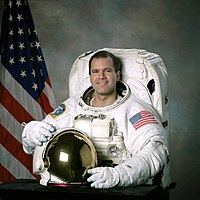Paul W. Richards
| Paul Richards | |
|---|---|

|
|
| Country: | United States |
| Organization: | NASA |
| selected on | May 1, 1996 ( 16th NASA Group ) |
| Calls: | 1 space flight |
| Begin: | March 8, 2001 |
| Landing: | March 21, 2001 |
| Time in space: | 12d 19h 49m |
| EVA inserts: | 1 |
| EVA total duration: | 6h 21m |
| retired on | February 2002 |
| Space flights | |
|
|
Paul William Richards (born May 20, 1964 in Scranton , Pennsylvania , USA ) is an American astronaut .
Career
Richards studied mechanical engineering and received a bachelor's degree from Drexel University in 1987 and a master's degree from the University of Maryland in 1991 .
From 1983 to 1987 he worked as an engineer in the United States Navy . 1987 he came to the Goddard Space Flight Center (GSFC) of NASA .
Astronaut activity
In April 1996, Richards was selected by NASA as an astronaut aspirant and then trained as a mission specialist.
On March 8, 2001, Richards took off on the space shuttle Discovery for its first flight into space . During this mission ( STS-102 ) to the International Space Station (ISS), the first long-term crew was replaced by a new crew and brought back to Earth. In addition, the multi-purpose logistics module Leonardo was taken to the ISS in order to supply the station with supplies. Richards undertook a space exit where he and Andrew Thomas installed an External Stowage Platform (ESP-1) and a replacement ammonia cooling pump on the outside of the Destiny module .
After his space flight he was still on the replacement team for the ISS regular crew 7 . In February 2002, however, he retired from the active NASA astronaut corps and is currently Observatory Manager for the Geostationary Operational Environmental Satellite Project (GOES) at the Goddard Space Flight Center.
Private
Paul Richards is married and has four children.
See also
- List of spacemen
- List of space shuttle missions
- List of manned space flights
- List of manned missions to the International Space Station
Web links
- Short biography of Paul W. Richards at spacefacts.de
- NASA biography of Paul W. Richards (English; PDF)
- Biography of Paul W. Richards in the Encyclopedia Astronautica (English)
| personal data | |
|---|---|
| SURNAME | Richards, Paul W. |
| ALTERNATIVE NAMES | Richards, Paul William |
| BRIEF DESCRIPTION | American astronaut |
| DATE OF BIRTH | May 20, 1964 |
| PLACE OF BIRTH | Scranton , Pennsylvania , Pennsylvania |